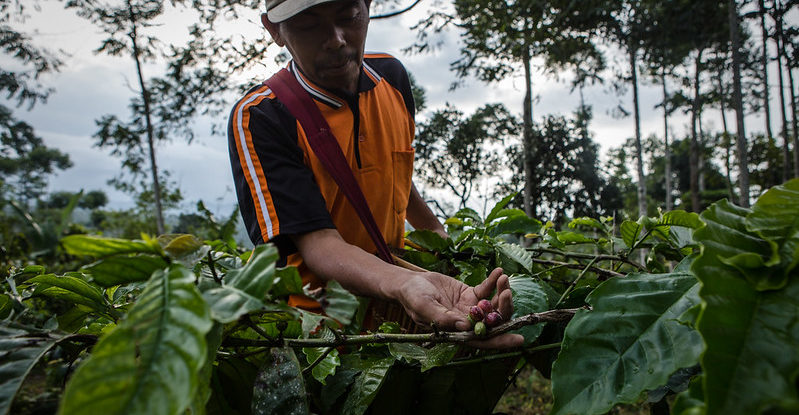The success of community-based forestry (CBF) in Indonesia can be enhanced by considering the different physical characteristics of each site and providing the technical support needed to balance the program’s dual mandate of conservation and poverty alleviation, scientists say.
The elevation, slope and proximity to infrastructure – such as roads and villages – affect the outcomes of CBF initiatives and determine the perceptions of farmers in each location.
Government support is needed to identify tree species that can help meet reforestation targets in various landscapes while providing clear livelihood benefits, according to a new study sponsored by the U.S. Agency for International Development and the Center for International Forestry Research (CIFOR).
“The designation of CBF needs to carefully examine the landscape’s ability to support an agroforestry system that enables cash crops to grow alongside canopy trees as well as other forest-friendly species that protect the integrity of the landscape,” says Andika Putraditama, the study’s lead author.
Local communities that manage or own forest resources under CBF programs account for as much as 15 percent of total forest areas worldwide. Indonesia, which recognized local people’s rights to participate in formal forest management decisions as early as 1995, has more than doubled the land designations under its Social Forestry program in recent years.
While progress has been slower than expected, partly due to boundary disputes and budget shortfalls at local level, the initiative promises to improve the livelihoods of 16.3 million rural inhabitants within or around forest areas in Indonesia. CBF is designed to curb deforestation and restore degraded land through increased property rights for local people.
The three authors of the study focused on two community forests in Lampung province, situated on the southernmost tip of Sumatra island. Through interviews and focus group discussions, they found that participating farmers were primarily interested in securing land tenure through the CBF initiatives – known as Hutan Kemasyarakatan (HKM) – and boosting their incomes from livelihood crops, such as coffee and pepper.
HKM farmers were able to buy land outside the forest estate, build homes, own more than one motorcycle per household, and send their children to boarding schools, the study found. They also reported environmental benefits, such as a lack of forest fires and air pollution due to a monitoring and warning system organized among themselves.
Farmers at the study sites were willing to follow government rules in exchange for land tenure to cultivate the area, but they were less motivated to restore degraded forest through tree planting if it lessened their chances of economic benefit.
The dilemma of reconciling conservation with livelihood improvement is evident in higher elevation sites with steeper slopes. In such locations, forest degradation is less likely to occur due to a lack of access, but farmers also have fewer crop options, thus reducing their motivation to restore degraded areas, the authors wrote.
The future designation of HKM sites should consider the land’s physical environment to ensure that farmers have many livelihood-crop options so that they are less inclined to convert their land into monoculture plantations, according to the study.
Potential sites can be evaluated using remotely sensed spatial data and supplement the information available in the Indicative Map of Social Forestry, a detailed overview of feasible HKM locations mapped by Indonesia’s Ministry of Environment and Forestry.
“Spatial technology can be used to assess the quality, potential productivity and labor access of the site for CBF designation, and to set realistic goals,” says Yeon-Su Kim, a professor of ecological economics in the School of Forestry at Northern Arizona University, and one of the study’s authors. “As we saw in one HKM with high elevation and remote access, it is unreasonable to expect the communities to reforest when they do not know what species of trees would grow well on their site and would provide some direct benefits.”
While CBF implementation in Indonesia has been greatly improved in recent years with massive support from the central government, there are some areas that could be enhanced, according to Putraditama. These include evaluating the long-term mandatory restoration targets of CBF units; increasing funding and capacity building for forest management units in CBF-dense jurisdictions; and refining site designations for future CBF units to increase the probability of achieving the dual goals of conservation and sustainable livelihood.
“When local communities gain access and management rights to forests, they have incentives to engage in restoration activities,” says Himlal Baral, a CIFOR senior scientist who contributed to the study. “This study helps policymakers to ensure the economic benefits of community forestry and thereby promote the success of conservation efforts.”
We want you to share Forests News content, which is licensed under Creative Commons Attribution-NonCommercial-ShareAlike 4.0 International (CC BY-NC-SA 4.0). This means you are free to redistribute our material for non-commercial purposes. All we ask is that you give Forests News appropriate credit and link to the original Forests News content, indicate if changes were made, and distribute your contributions under the same Creative Commons license. You must notify Forests News if you repost, reprint or reuse our materials by contacting forestsnews@cifor-icraf.org.
